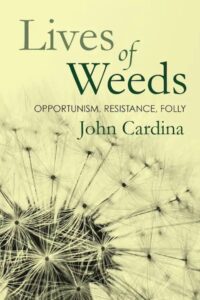 The common definition of a weed is a wild plant growing in a place where humans don’t want it to be growing. The problem with this – aside from it being astonishingly arrogant of us toward the complexity of the natural world – is that it is also short-sighted, in that there may well be, and very likely is, more to the plant in question growing where it is growing than we can readily perceive and understand.
The common definition of a weed is a wild plant growing in a place where humans don’t want it to be growing. The problem with this – aside from it being astonishingly arrogant of us toward the complexity of the natural world – is that it is also short-sighted, in that there may well be, and very likely is, more to the plant in question growing where it is growing than we can readily perceive and understand.
Prof. John Cardina understands much more about weeds than most people – including how we have played a role in their development and spread. In his recently published book Lives of Weeds; Opportunism, Resistance, Folly, he examines the histories and biology of eight plants – Dandelion, Florida Beggarweed, Velvetleaf, Nutsedge, Marestail, Pigweed, Ragweed, Foxtail – presenting “a fresh perspective on how these tenacious plants came about, why they are both inevitable and essential, and how their ecological success is ensured by determined efforts to eradicate them.”
As one who has, particularly over the past few years, made an effort to not only learn more about plants but to understand them as they are rather than how I or anyone else might want them to be, I am very excited to be reading Prof. Cardina’s new book in hope of discovering more about some of the plants we commonly denigrate and as a result deepening my understanding of the role they play in the world.
Available from:
If you enjoyed reading this, please consider signing up for The Well-read Naturalist's newsletter. You'll receive a helpful list of recently published reviews, short essays, and notes about books in your e-mail inbox once each fortnight.

